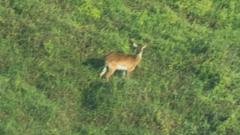The beloved crested crane of Uganda is experiencing alarming population declines due to habitat loss, agricultural conflicts, and illegal hunting practices. Conservationists urge immediate protective measures as the bird faces possible extinction.
Crested Crane Faces Critical Threats as Habitat Shrinks in Uganda

Crested Crane Faces Critical Threats as Habitat Shrinks in Uganda
Once a symbol of culture and pride, Uganda's crested crane is on the brink of extinction due to habitat destruction and increasing farmer conflicts.
The crested crane, an emblem of grace adorned with a golden crown and red throat pouch, is facing mounting threats to its existence in Uganda, its home. Found on the nation's flag and coat of arms, this striking bird, known for its slender black legs and iconic stature, has become a national treasure. However, its population has plummeted, threatening its survival and prompting urgent calls for conservation intervention.
Legally protected, the crested crane cannot be killed without severe penalties – a life sentence or a hefty fine equivalent to $5 million. Traditionally revered in Buganda culture, local superstition once ensured the safety of these cranes. The belief that killing a crane would lead to the killer's eventual demise kept them safe for centuries. Yet, as modern pressures increase, this respect is eroding among farmers struggling with crop losses attributed to the birds.
In western Uganda, where these cranes frequently feed, farmers like Tom Mucunguzi express growing animosity towards them. "I really don't see any value in these birds," he asserts, stressing his concerns over crop raiding and food security. Fellow farmer Fausita Aritua similarly laments the challenges of deterring the cranes from her maize fields.
The grey-crowned cranes are not exclusively found in Uganda. They inhabit several East African nations. With a height of 1 meter (3.2 feet), these non-migratory birds are typically situated in wetlands. However, soaring human populations and agricultural encroachment have stripped them of their habitats, pushing the crested crane's numbers down by over 80% in the past 25 years. In the 1970s, Uganda was home to over 100,000 crested cranes; now, the figure is roughly 10,000, which has led to their classification as endangered by the International Union for the Conservation of Nature (IUCN).
Tragic incidents of poisoning have further exacerbated the situation. Conservation officer Gilbert Tayebwa warns of a startling increase in cranes being killed unintentionally by farmers trying to protect their crops. In contrast, some farmers, like Philip Ntare, respect the traditional wisdom and chase cranes away instead of harming them. Notably, farmers express a desire for governmental intervention, seeking financial compensation for crop losses caused by the protected birds, but officials clarify that the government cannot be held liable for such damages.
Unfortunately, the cranes face threats beyond agricultural conflicts. Their natural breeding spaces are also at risk, leading to increased predator activity and accidents involving power lines. Moreover, their striking appearance has made them targets for pet trade and traditional remedies, threatening their populations even further.
Conservationists are tirelessly addressing these myriad challenges. Efforts are underway to rehabilitate and protect wetlands, with Uganda's government highlighting the significance of conservation in recent initiatives. These include appointing local custodians for crane monitoring and establishing laws against hunting. While some strides have been made, experts like Dan Sseruge warn that without immediate and comprehensive action, the crested crane may slip into extinction in the near future.
With early morning outings becoming the only reliable way to spot these stunning birds, the urgent need for awareness and action is crystal clear. It remains to be seen whether Uganda can stem the tide of decline and preserve this national icon for generations to come.





















